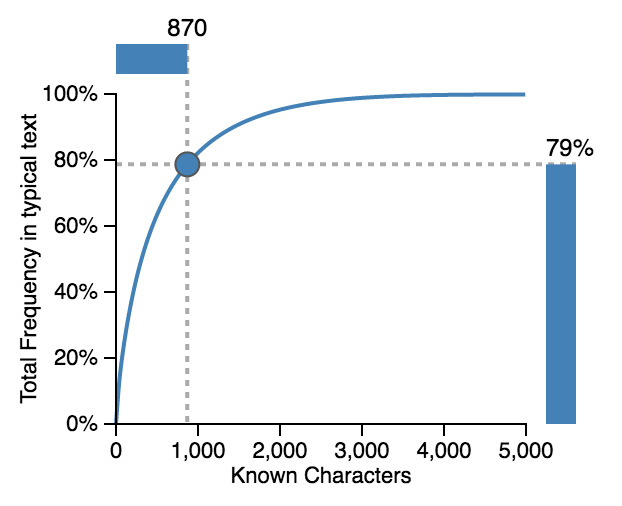With thousands of Chinese characters to master, it can be daunting to get going and plough through them.
To help you out a bit, we encourage you to try WordSwing’s Written Word spaced repetition gadget:
This gadget will introduce the most frequent 870 Chinese characters in descending frequency order, that is, the most common ones first.
Learning characters in frequency order allows you to benefit from the very steep cumulative frequency curve intrinsic to the Chinese language. I’ll illustrate with a plot from WordSwing’s Character Knowledge Estimator:
This plot illustrates how the number of characters you know (horizontal axis) relates to the fraction of typical text that is comprised of those characters (vertical axis). This curve is drawn assuming that the probability you know a character is proportional to the frequency of the character. So in the plot above, if you know 870 characters then you can recognize the characters comprising 79% of typical text.
Now, if you learn the characters in strict frequency order then the curve is even slightly steeper. Thus, if you go through all 870 characters that are part of our Written Word SRS gadget then you will actually know characters corresponding to 86% of typical text. In contrast, if you were to just pick 870 characters completely at random from the ~5000 or so most common characters, on average these would comprise only 9% of typical text. So it’s really worth focusing on the common ones first.
By learning the 870 most common characters, you get 86% of typical text, with a random batch of 870 characters you would only get 9%!
Why yet another SRS tool?
Spaced repetition is one of the most powerful tools in the vocabulary learning toolbox. If you’re not familiar with it, check out Hacking Chinese's introduction to SRS.
WordSwing’s version of spaced repetition works much like the popular Anki spaced repetition program, although our version is not designed as a general purpose tool.
Instead, it’s optimized to the task of learning Chinese characters. There are a number of features that make it particularly well-suited to character learning:
- As characters are introduced, common words that are comprised solely of already-introduced characters will be added to the mix. Adding words along the way allows you to practice the characters in the context of the words in which they are used, giving your brain more fodder for building associations.
- When you review a composite word, like 学生, if you indicate that you still remember it, then this also affects the review intervals for 学 and 生. In this way we leverage the intrinsic structure of the language to reduce the number of card views to get all vocabulary items to the highest review stage. However, if you indicate you don’t remember 学生 then this doesn’t affect the review intervals for 学 or 生 because it’s not clear which part you forgot or whether you simply forgot that those two characters form this word.
- At each iteration, you explicitly choose whether you want to introduce a new character, review an item, or introduce a new word. This gives you full control over the balance of new material and keeping your review queue manageable.
- The gadget is wired up to the rest of WordSwing, so you have immediate access to related words, character decompositions, example sentences etc. By taking a moment to drill down and explore a word, you’re giving your brain a chance to make additional associations that will help embed the new vocabulary item in your long-term memory.
We hope you enjoy our new gadget and, as always, welcome any and all feedback you have.
Have fun learning!

